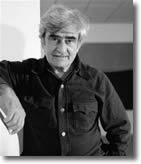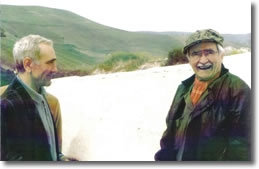
The Genesis and the history of the “Cretto” by Alberto Burri At a meeting of Gibellina City
Council on the 25 of September 1979 it was resolved, following
the advice of Mayor Ludovico In a newspaper article of April 2006 calling for the completion of the monuments, known as the Cretto, the now Senatore Ludovico Corrao recalls Burri’s first visit and the genesis of the Cretto as a monument. A few days after the personal invitation was issued, Burri had relented and arrived in Sicily. He wanted to meet with the locals and was taken through the elaborate, newly erected welcome gate, Stella, a sculpture by Pietro Consagra, into the now mostly completed new city. Corrao does not elaborate on the visit to this location. We known that Burri thought that “in this place for sure there is nothing for me to contribute as the place has plenty works of art.” Alberto Zanmatti, the architect involved in the project, in his comment on this said that knowing Burri, he would have never agreed to be one of many. At Burri’s request, Corrao took him to the site of the destroyed old city. The sight of the devastation and ruins brought Burri close to tears, but Burri remained silent. They continued and drove to Segesta to the ruins of an old Greek amphitheatre that Burri wanted to photograph at dusk. There he told Corrao, “I have the project in mind” but did not elaborate. The archaeology of the future. A Cretto resembles a dried up clay lake bed. Burri started incorporating craked surfaces into his work with other materials as early as 1951, turning the Cretto into a painting in the 70s. On the genesis of the Cretto, Burri says: “when I was in California, I often visited Death Valley. The idea came from there, but then in the painting it became something else. I only wanted to demonstrate the energy of the surface.” The Cretto design had also been used by Burri in sculptures. In 1976 and 77 he created two ceramic sculpture walls (5 x 15m), one for the Franklin D. Murphy Sculpture Garden in UCLA, Los Angles, and the other is located at the Capodimonte Museum in Naples. Another sculpture based on the Cretto design is a metal Grande Ferro of 1980 (5.18 x 0.61m) located in Palazzo Albizzini, Collezione Burri, in Città di Castello. Burri produced his Cretto paintings in collaboration with the forces of nature, in this case, a chemical reaction that causes the surface of the material, when it dries up, to crack. It is a process of destruction/construction that also involves time. The eventual destruction of the surface becomes the construction of the work. The material he used to produce the Cretto was a mixture of wet kaolin, resin, pigment and polyvinyl acetate that was applied as a smooth layer on to a horizontal surface. By changing the composition of the chemicals, the concentration of the catalysts and the depth of the layers the artist was able to control the density of the cracking, but not the exact location of the cracks. The enormity of the Gibellina project did
not become apparent until 1981 when Burri presented the city with
a model of the Alberto Burri and “The International Land Art Panorama”. Each section of the Cretto, averaging 700 sq.m, had to be surrounded by reinforced concrete, with the rubble piled and compacted into it to a height of 1.6 m. and the whole covered by a layer of white cement. The gaps between the sections, the walkways, were paved in white cement; these gaps form gullies of varying width from 1.5m to 4m. The army was called in to assist with the clearing of the ruins. All the debris and everything found on site in the ruined buildings, included clothing, dolls, wine and olive oil bottles, farming implements and household items, were piled and buried in the confined perimeter of each section. Fondazione Orestiadi, the new beginning. For the casual visitor guided to the place by the sign Gibellina Ruderi (Gibellina ruins), after expressing astonishment at this huge apparition of cracked off white cement in the middle of a rural setting, questions of – What is it? Why is it here? – come to mind. It is useless to look for an explanatory sign, as there is none there. There are a few signs honoring the latest financial donor that mention the earthquake, but these are incorporated into the cement walls and are hard to find. However a feeling that an event, that connects the structure to the site, had occurred there, soon creeps in. The question of what the event was is answered by the few ruined structures that are still standing, by the upturned land, and the abruptly ending roads that abound in the area and the separation from the cultivated land. The scale of the event is transmitted, when wandering through the cracks does not transmit a sensation of desperation such as being lost, on the contrary, it transmits a sensation of adventure, as at no time, despite the silence within the structure, in the cultivated land surrounding it is obscured; it remains visible between the cracks and over the top of the structure, and completes the integration of the monument with the living landscape that surrounds it. |
 Corrao,
to issue an official invitation to Alberto Burri. The resolution
read as follows: “The merit and
significance of your artistic message is considered to be human
and poetically inspiring more than any other it is
able to translate for the present generation and for future generations
the tragedy, the struggle, the hope and the faith in the
land of the people of Gibellina”. They asked Burri
to add one of his works to the many artists’ contributions
already scattered in the new town. As Burri did not react, the
Mayor went to visit him at his home in Città di Castello
and issued him a personal invitation to be a guest at his home.
Corrao,
to issue an official invitation to Alberto Burri. The resolution
read as follows: “The merit and
significance of your artistic message is considered to be human
and poetically inspiring more than any other it is
able to translate for the present generation and for future generations
the tragedy, the struggle, the hope and the faith in the
land of the people of Gibellina”. They asked Burri
to add one of his works to the many artists’ contributions
already scattered in the new town. As Burri did not react, the
Mayor went to visit him at his home in Città di Castello
and issued him a personal invitation to be a guest at his home. monument. In the model, Burri had recreated in plastic,
an aerial view of the topography of Old Gibellina and its surroundings
on which he had superimposed a Cretto that covered the side of
the destroyed old city. The footprint of Old Gibellina’s
main street and one other thoroughfare were incised into the work,
while the rest of the Cretto cracks has been allowed to form spontaneously.
monument. In the model, Burri had recreated in plastic,
an aerial view of the topography of Old Gibellina and its surroundings
on which he had superimposed a Cretto that covered the side of
the destroyed old city. The footprint of Old Gibellina’s
main street and one other thoroughfare were incised into the work,
while the rest of the Cretto cracks has been allowed to form spontaneously.



